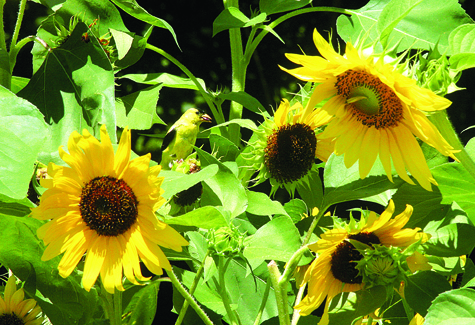A forum for anyone who wants to learn more about gardening

Thirty-five years after Cornell Cooperative Extension began its master gardener program on the East End, the program’s spring gardening school, to be held this weekend at Riverhead High School, is still chock-full of lectures that will give even experienced gardeners ideas for projects they’ve never tried before.
Master gardeners are volunteers with gardening expertise, chosen throughout the state by Cornell, who give their time to share their knowledge in various specialty areas of a hobby that often takes a lifetime to master.
Saturday’s program includes 30 lectures, offering advice on everything from the care of houseplants to specialty vegetable gardening to soil health, roses, figs and floral design.
Cornell educator Caroline Kiang has trained about 1,200 master gardeners since she began Suffolk County’s master gardener program 29 years ago. Those gardeners then go out into the community and help beautify neighborhoods and advise community gardening groups.
“The master gardeners decentralize the effort, and we can reach more people,” said Ms. Kiang.
Jamesport resident Nancy Gilbert has been teaching in the master gardener program since 2002, not long after she and her husband, Richard Wines, left careers on Wall Street to live full time on their 15-acre farm, Winds Way, just off Peconic Bay Boulevard.
They grow it all, from vegetables to bulbs to apple trees, but Ms. Gilbert’s lectures on Saturday will focus on how to grow a garden that will attract birds.
For Ms. Gilbert, making birds comfortable in the garden is a wholistic approach to the interconnectedness of species, soil and sky.
She avoids the monoculture of lawns, which suck up water and provide little habitat for one of birds’ favorite foods: insects.
“All baby birds are fed insects,” she said, even if they are more likely to consume berries or seeds as adults.
To be a top-notch bird gardener, she says, you need to also scale back on manicuring your property. Brush piles, which are frowned upon by modern suburban landscapers, offer birds essential places to hide from predators, storms and winter’s cold.
Leaf litter left in the garden not only helps add nutrients to the soil, but helps birds to find insects and nest materials.
“And you can’t chop down every dead branch in a tree,” she added. “You’re much better off leaving some bird hotels around.”
Perhaps most importantly, gardening for the birds also involves thinking in three dimensions, as if you are imagining you could fly.
“You need to garden in layers, with ground cover, low plants, shrubs and a canopy,” she said. “Birds have to be able to move vertically. The flat green lawn with foundation plantings — it’s really too bad that became the cultural norm. It eliminates habitat.”
After changing those basic habits, Ms. Gilbert said, “It’s really about plants for food and shelter, and about water.”
“Of those variables, water is probably the most important,” she said. Birds need to keep their feathers clean in order to fly properly and keep themselves warm by puffing them up. This is most important in the winter, when many water sources are frozen, so a heated birdbath or pond is one of the essential components of Ms. Gilbert’s bird garden plan.
“They’re relatively inexpensive, and much better than pouring boiling water in a birdbath,” she said.
Most fruit- and seed-bearing plants are attractive to birds, and Ms. Gilbert likes to focus on using native elements that might already exist in gardens. Common local plants, from bayberry to cedar trees, provide ideal food sources. Other plants that many consider weeds — like milkweed, goldenrod and common mullein — are loved by birds, butterflies and honeybees.
She urges caution about several plants sold at nurseries that became wildly popular on Long Island, only to become invasive species. Barberry and winged euonymus, known as burning bush, have become famous for their escape from gardens and their stranglehold on native areas.
Ms. Gilbert urges gardeners to plant flowering dogwoods, because a fungal disease has destroyed a lot of native dogwoods, which produce a berry that birds love and that is high in lipids and vitamin C. She said much work has been done recently to breed disease-resistant dogwoods, which are available at local nurseries. She urges gardeners to ask nursery workers about the young trees’ disease resistance before buying.
For seed-loving birds, she recommends planting flowers with large seed heads, especially purple coneflower and black-eyed Susans. The birds won’t eat the seeds until the flower has withered and dried, challenging to traditional gardeners to resist the urge to deadhead their flowers.
Of course, once you start attracting songbirds, predators may not be far behind. Ms. Gilbert has seen Cooper’s hawks and sharp-shinned hawks kill smaller birds in her backyard, and feral cats are an ever-present nuisance. Gardeners need to come to terms with these predator-prey relationships. They must also realize and accept that if you plant berries for yourself in your bird garden, you’re going to have to share them with the birds.
“My attitude is, there’s enough for everybody,” she said.
Ms. Gilbert will give out more advice on planting for the birds at her workshop, scheduled at 1 p.m. and again at 2:30.
Spring Gardening School
SPONSORED BY
Cornell Cooperative Extension
Saturday, April 16, 8:30 a.m. to 4 p.m., at Riverhead High School. Admisson: $55 in advance/$60 at the door, includes four classes, meals, soil tests and plant diagnosis. Call 727-7850, ext. 345 or 347.






